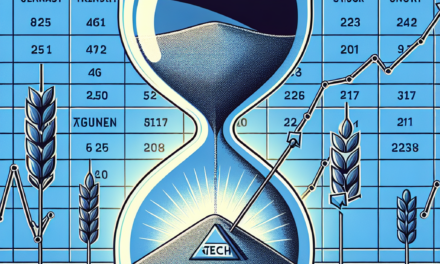“Rising Dollar, Shifting Fed: Stocks Feel the Squeeze”
Introduction
The dollar’s recent strengthening has emerged as a pivotal factor in global financial markets, driven by shifting expectations surrounding the Federal Reserve’s monetary policy outlook. As investors recalibrate their forecasts in response to evolving economic indicators and central bank communications, the greenback’s appreciation is exerting downward pressure on equities. This dynamic reflects a complex interplay between currency valuations and stock market performance, as a stronger dollar often weighs on multinational corporations’ earnings and dampens investor sentiment. The market summary delves into the implications of these developments, analyzing how the Fed’s changing stance is influencing asset prices and shaping investment strategies.
Impact Of Fed Policy Shifts On The Dollar’s Strength
The recent shifts in the Federal Reserve’s policy outlook have significantly impacted the strength of the U.S. dollar, creating ripples across global financial markets. As the Federal Reserve signals a more hawkish stance, the dollar has experienced a notable appreciation, exerting pressure on stock markets both domestically and internationally. This development underscores the intricate relationship between monetary policy and currency valuation, as well as the broader implications for financial markets.
To begin with, the Federal Reserve’s policy decisions are pivotal in shaping the economic landscape, influencing everything from interest rates to inflation expectations. Recently, the Fed has indicated a potential shift towards tightening monetary policy sooner than previously anticipated. This change is primarily driven by persistent inflationary pressures and a robust labor market recovery, prompting the central bank to consider raising interest rates to prevent the economy from overheating. As a result, investors have recalibrated their expectations, leading to a surge in demand for the U.S. dollar.
The strengthening of the dollar can be attributed to several factors. Firstly, higher interest rates typically attract foreign capital, as investors seek better returns on their investments. This influx of capital increases demand for the dollar, driving up its value. Additionally, the dollar is often viewed as a safe-haven currency, particularly in times of economic uncertainty. With the Fed’s hawkish pivot, investors are increasingly seeking refuge in the dollar, further bolstering its strength.
However, the appreciation of the dollar has not been without consequences. One of the most immediate effects has been the pressure exerted on stock markets. A stronger dollar can negatively impact U.S. multinational companies, as it makes their goods and services more expensive for foreign buyers. This, in turn, can lead to reduced revenues and profit margins, ultimately weighing on stock prices. Moreover, a robust dollar can also dampen the competitiveness of U.S. exports, further challenging the earnings potential of companies with significant international exposure.
In addition to affecting corporate earnings, the dollar’s strength has broader implications for global financial markets. Emerging markets, in particular, are vulnerable to fluctuations in the dollar’s value. Many emerging economies rely heavily on dollar-denominated debt, and a stronger dollar can increase the burden of servicing this debt, potentially leading to financial instability. Furthermore, as the dollar appreciates, capital flows may shift away from these markets, exacerbating economic challenges and heightening volatility.
Despite these challenges, it is important to recognize that the dollar’s strength is not solely a result of domestic factors. Global economic conditions, geopolitical tensions, and other external influences also play a role in shaping currency dynamics. Nevertheless, the Federal Reserve’s policy outlook remains a key driver of the dollar’s trajectory, and market participants will continue to closely monitor any developments in this regard.
In conclusion, the recent strengthening of the U.S. dollar, driven by changes in the Federal Reserve’s policy outlook, has had significant implications for financial markets. While the dollar’s appreciation reflects investor confidence in the U.S. economy, it also poses challenges for stock markets and emerging economies. As the Fed navigates the complex landscape of monetary policy, the interplay between interest rates, inflation, and currency valuation will remain a focal point for investors and policymakers alike. Understanding these dynamics is crucial for anticipating future market movements and making informed investment decisions.
How A Stronger Dollar Affects Global Stock Markets
The recent strengthening of the U.S. dollar has captured the attention of global investors, as shifts in the Federal Reserve’s monetary policy outlook have exerted significant pressure on stock markets worldwide. This development is not merely a domestic concern; rather, it has far-reaching implications for international financial markets. As the dollar appreciates, it creates a ripple effect that influences various aspects of the global economy, including trade balances, corporate earnings, and investment flows.
To begin with, a stronger dollar makes U.S. exports more expensive for foreign buyers, potentially reducing demand for American goods and services abroad. This can lead to a widening trade deficit, as imports become relatively cheaper for U.S. consumers. Consequently, companies that rely heavily on exports may experience a decline in revenue, which can negatively impact their stock prices. Moreover, multinational corporations with significant overseas operations may face currency translation losses when converting foreign earnings back into dollars, further dampening their financial performance.
In addition to affecting trade dynamics, the appreciation of the dollar can also influence global capital flows. As the dollar strengthens, it often attracts foreign investment into U.S. assets, such as Treasury bonds and equities, due to the perceived safety and higher returns. This influx of capital can lead to a tightening of financial conditions in emerging markets, as investors withdraw funds to seek better opportunities in the United States. Emerging market economies, which often have debt denominated in dollars, may find it more challenging to service their obligations, leading to increased financial stress and potential volatility in their stock markets.
Furthermore, the impact of a stronger dollar extends to commodity markets, as many commodities are priced in dollars. When the dollar appreciates, commodities become more expensive for buyers using other currencies, potentially reducing demand and putting downward pressure on prices. This can adversely affect the stock prices of companies in the commodity sector, such as those involved in oil, mining, and agriculture. Additionally, countries that are major exporters of commodities may experience economic slowdowns, further influencing their stock markets.
It is also important to consider the role of central banks in this complex landscape. As the Federal Reserve adjusts its monetary policy stance, other central banks may respond by altering their own policies to mitigate the impact of a stronger dollar on their economies. This can lead to a divergence in interest rates and monetary policies across countries, adding another layer of complexity to the global financial environment. Investors must navigate these changes carefully, as they can create both risks and opportunities in different regions and sectors.
In conclusion, the strengthening of the U.S. dollar, driven by changes in the Federal Reserve’s outlook, has significant implications for global stock markets. From affecting trade balances and corporate earnings to influencing capital flows and commodity prices, the ripple effects of a stronger dollar are felt across the world. As investors assess these developments, they must remain vigilant and adaptable, recognizing that the interconnectedness of global markets requires a nuanced understanding of how currency movements can shape economic and financial landscapes. By staying informed and responsive to these dynamics, investors can better position themselves to navigate the challenges and opportunities that arise in an ever-evolving global market.
The Relationship Between Fed Decisions And Currency Valuation
The intricate relationship between Federal Reserve decisions and currency valuation is a subject of perennial interest to economists and investors alike. Recently, the U.S. dollar has experienced a notable strengthening, a development closely tied to shifting expectations regarding the Federal Reserve’s monetary policy. This change in the dollar’s valuation has exerted pressure on stock markets, illustrating the complex interplay between currency strength and equity performance.
To understand this dynamic, it is essential to consider the role of the Federal Reserve in setting interest rates, which are a primary tool for influencing economic activity. When the Fed signals a potential increase in interest rates, it often leads to a stronger dollar. This is because higher interest rates tend to attract foreign investment, as investors seek the higher returns that U.S. assets can offer. Consequently, demand for the dollar increases, driving up its value relative to other currencies.
In recent months, the Federal Reserve has indicated a more hawkish stance, suggesting that interest rate hikes may be on the horizon. This shift in outlook has been driven by a combination of factors, including persistent inflationary pressures and a robust labor market. As a result, market participants have adjusted their expectations, leading to a rally in the dollar. The appreciation of the dollar, while beneficial for certain sectors, poses challenges for others, particularly those with significant international exposure.
For multinational corporations, a stronger dollar can erode overseas profits when they are repatriated back to the United States. This is because foreign earnings, when converted into a stronger dollar, result in lower dollar-denominated revenues. Consequently, companies with substantial international operations may face downward pressure on their stock prices. Additionally, a strong dollar can make U.S. exports more expensive and less competitive on the global stage, potentially impacting the revenues of export-oriented businesses.
Moreover, the relationship between a strong dollar and stock market performance is further complicated by investor sentiment. As the dollar strengthens, it often signals confidence in the U.S. economy, which can be a positive indicator for domestic equities. However, the prospect of rising interest rates can also lead to increased borrowing costs for companies, potentially dampening investment and expansion plans. This dual effect creates a nuanced environment where investors must weigh the benefits of a strong dollar against the potential drawbacks of higher interest rates.
In this context, it is crucial for investors to remain vigilant and adaptable. Monitoring Federal Reserve communications and economic indicators can provide valuable insights into future monetary policy shifts. Additionally, diversification across asset classes and geographic regions can help mitigate the risks associated with currency fluctuations and interest rate changes.
In conclusion, the strengthening of the dollar in response to changing Federal Reserve outlooks underscores the intricate relationship between monetary policy and currency valuation. While a robust dollar can signal economic strength, it also presents challenges for certain sectors and complicates the investment landscape. As the Fed continues to navigate the delicate balance between fostering economic growth and controlling inflation, market participants must remain attuned to the evolving dynamics that influence both currency and equity markets.
Analyzing The Stock Market’s Reaction To A Strengthening Dollar

The recent shift in the Federal Reserve’s outlook has led to a notable strengthening of the U.S. dollar, exerting pressure on stock markets both domestically and internationally. This development comes as investors recalibrate their expectations regarding interest rates and monetary policy, which in turn influences currency valuations and equity markets. As the dollar appreciates, it creates a ripple effect across various sectors, impacting corporate earnings, trade balances, and investment strategies.
To begin with, the strengthening of the dollar can be attributed to the Federal Reserve’s signals of a more hawkish stance on monetary policy. As inflationary pressures persist, the Fed has indicated a willingness to raise interest rates more aggressively than previously anticipated. This prospect of higher interest rates makes dollar-denominated assets more attractive to investors, thereby increasing demand for the currency. Consequently, the dollar’s value rises relative to other currencies, which can have significant implications for multinational corporations and their earnings.
For companies that generate a substantial portion of their revenue overseas, a stronger dollar can be a double-edged sword. On one hand, it can reduce the cost of importing goods and services, potentially improving profit margins. On the other hand, it can also lead to a decrease in the competitiveness of U.S. exports, as American goods become more expensive for foreign buyers. This dynamic can result in lower sales volumes and reduced revenue when foreign earnings are converted back into dollars. As a result, sectors such as technology and manufacturing, which have significant international exposure, may face headwinds in the form of currency translation losses.
Moreover, the impact of a stronger dollar extends beyond corporate earnings to influence broader economic indicators. A robust dollar can contribute to a widening trade deficit, as imports become cheaper and exports more costly. This shift in trade dynamics can affect economic growth projections and, by extension, investor sentiment. Additionally, emerging markets, which often have debt denominated in U.S. dollars, may experience increased financial strain as their local currencies depreciate against the dollar. This can lead to capital outflows and heightened volatility in these markets, further complicating the global economic landscape.
In light of these factors, stock markets have reacted with increased volatility and downward pressure on indices. Investors are reassessing their portfolios, taking into account the potential impact of a stronger dollar on corporate profitability and economic growth. As a result, there has been a rotation away from growth-oriented stocks, which are more sensitive to changes in interest rates and currency fluctuations, towards value stocks that may offer more stability in uncertain times. This shift in investment strategy underscores the interconnectedness of currency markets and equity markets, highlighting the importance of a comprehensive approach to market analysis.
In conclusion, the strengthening of the U.S. dollar, driven by changes in the Federal Reserve’s outlook, has created a complex environment for stock markets. As investors navigate this landscape, they must consider the multifaceted effects of currency movements on corporate earnings, trade balances, and global economic conditions. By understanding these dynamics, market participants can make more informed decisions and better position themselves to manage the risks and opportunities that arise from a changing monetary policy landscape.
Economic Implications Of A Strong Dollar On International Trade
The recent strengthening of the U.S. dollar, driven by shifting expectations regarding the Federal Reserve’s monetary policy, has significant implications for international trade. As the dollar appreciates, it exerts pressure on global markets, particularly affecting the competitiveness of U.S. exports and the cost of imports. This dynamic is crucial for understanding the broader economic landscape and its impact on international trade relations.
To begin with, a stronger dollar makes U.S. goods more expensive for foreign buyers. This can lead to a decrease in demand for American products abroad, as international consumers may opt for cheaper alternatives from other countries. Consequently, U.S. exporters may experience a decline in sales, which can negatively impact their revenues and profitability. This situation is particularly challenging for industries that rely heavily on exports, such as manufacturing and agriculture. As these sectors face reduced demand, they may be forced to cut costs, potentially leading to job losses and decreased economic activity domestically.
Moreover, the appreciation of the dollar affects the cost of imports. While a stronger dollar makes foreign goods cheaper for American consumers, it can also lead to increased competition for domestic producers. U.S. companies that compete with imported goods may find it difficult to maintain their market share, as consumers are drawn to the lower prices of foreign products. This increased competition can pressure domestic firms to reduce prices, which may squeeze profit margins and hinder investment in innovation and expansion.
In addition to these direct effects, the strong dollar has broader implications for global trade balances. Countries with significant trade deficits with the United States may find it more challenging to reduce these imbalances, as their exports become less competitive in the U.S. market. This can exacerbate existing trade tensions and lead to calls for protectionist measures, such as tariffs and quotas, which can further disrupt international trade flows.
Furthermore, the impact of a strong dollar extends to emerging markets, which often have significant amounts of debt denominated in U.S. dollars. As the dollar strengthens, the cost of servicing this debt increases, putting additional financial strain on these economies. This can lead to reduced investment and slower economic growth in emerging markets, which can have ripple effects on global trade and economic stability.
Despite these challenges, there are also potential benefits to a strong dollar. For instance, U.S. consumers benefit from lower prices on imported goods, which can increase their purchasing power and support domestic consumption. Additionally, a strong dollar can attract foreign investment into the United States, as investors seek the relative safety and stability of dollar-denominated assets. This influx of capital can support economic growth and job creation, offsetting some of the negative impacts on exports.
In conclusion, the strengthening of the U.S. dollar, influenced by changes in the Federal Reserve’s outlook, presents a complex set of challenges and opportunities for international trade. While it can pressure U.S. exporters and increase competition for domestic producers, it also offers benefits such as lower import prices and increased foreign investment. As global markets continue to adjust to these dynamics, policymakers and businesses must carefully navigate the evolving economic landscape to mitigate risks and capitalize on potential opportunities. Understanding these implications is crucial for stakeholders seeking to adapt to the changing conditions and maintain a competitive edge in the global marketplace.
Investor Strategies Amidst A Strengthening Dollar And Market Volatility
As the dollar strengthens in response to shifting expectations regarding the Federal Reserve’s monetary policy, investors are faced with the challenge of navigating a volatile market environment. The recent appreciation of the U.S. dollar has been largely driven by speculation that the Federal Reserve may adopt a more hawkish stance, potentially raising interest rates sooner than previously anticipated. This development has significant implications for both domestic and international markets, as a stronger dollar can exert downward pressure on stock prices and impact global trade dynamics.
In light of these changes, investors are reevaluating their strategies to mitigate risks and capitalize on potential opportunities. One of the primary concerns is the impact of a stronger dollar on multinational corporations, which may experience reduced competitiveness abroad due to higher relative costs. Consequently, investors are scrutinizing companies with significant international exposure, as their earnings could be adversely affected by unfavorable currency exchange rates. In this context, a focus on domestically-oriented companies may offer a more stable investment avenue, as they are less susceptible to currency fluctuations.
Moreover, the strengthening dollar has implications for commodity markets, as many commodities are priced in U.S. dollars. A stronger dollar typically makes commodities more expensive for foreign buyers, potentially dampening demand and exerting downward pressure on prices. Investors with exposure to commodities may need to reassess their positions, considering the potential for price volatility and the broader impact on commodity-dependent sectors.
In addition to these considerations, the prospect of rising interest rates presents both challenges and opportunities for investors. On one hand, higher interest rates can lead to increased borrowing costs for companies, potentially squeezing profit margins and weighing on stock valuations. On the other hand, sectors such as financials may benefit from a rising rate environment, as banks and other financial institutions could see improved net interest margins. Consequently, investors may look to adjust their portfolios by increasing exposure to sectors that stand to gain from higher rates while reducing positions in more rate-sensitive areas.
Furthermore, the current market volatility underscores the importance of diversification as a risk management strategy. By spreading investments across a range of asset classes, sectors, and geographies, investors can potentially reduce the impact of adverse market movements on their portfolios. In this context, alternative investments such as real estate, infrastructure, and hedge funds may offer attractive diversification benefits, as they often exhibit low correlations with traditional equity and bond markets.
In conclusion, the strengthening of the U.S. dollar and the evolving outlook for Federal Reserve policy present a complex landscape for investors. By carefully considering the implications of these developments and adjusting their strategies accordingly, investors can better position themselves to navigate the challenges and opportunities that lie ahead. Emphasizing domestic companies, reassessing commodity exposures, capitalizing on sectoral shifts, and maintaining a diversified portfolio are all prudent approaches in this dynamic environment. As always, staying informed and agile will be key to successfully managing investments amidst the current market volatility.
Historical Trends: Fed Outlook Changes And Their Impact On The Dollar
The relationship between the Federal Reserve’s monetary policy outlook and the strength of the U.S. dollar has long been a subject of interest for economists and investors alike. Historically, changes in the Fed’s outlook have had significant implications for the dollar’s value, often exerting pressure on stock markets. Understanding these historical trends provides valuable insights into the current market dynamics, where the dollar has recently strengthened in response to shifts in the Fed’s policy stance.
Traditionally, the Federal Reserve’s monetary policy decisions, particularly those related to interest rates, have been a primary driver of the dollar’s strength. When the Fed signals a more hawkish stance, indicating potential interest rate hikes, the dollar tends to appreciate. This is because higher interest rates offer better returns on investments denominated in dollars, attracting foreign capital and increasing demand for the currency. Conversely, a dovish outlook, suggesting lower interest rates or quantitative easing, typically weakens the dollar as investors seek higher returns elsewhere.
Examining past instances, such as the Fed’s tightening cycle in the mid-1990s, reveals a pattern where the dollar strengthened significantly as the central bank raised rates to curb inflation. This period saw the dollar appreciating against major currencies, reflecting increased investor confidence in the U.S. economy’s prospects. Similarly, during the early 2000s, the Fed’s accommodative policies in response to economic downturns led to a weaker dollar, as lower interest rates reduced the currency’s appeal.
In more recent years, the global financial crisis of 2008 and the subsequent recovery period highlighted the Fed’s influence on the dollar. The central bank’s decision to implement quantitative easing and maintain near-zero interest rates for an extended period resulted in a prolonged phase of dollar weakness. However, as the economy recovered and the Fed began tapering its asset purchases, the dollar regained strength, underscoring the currency’s sensitivity to shifts in monetary policy.
Currently, the dollar’s strengthening can be attributed to the Fed’s evolving outlook in response to changing economic conditions. As inflationary pressures mount and the labor market tightens, the central bank has signaled a potential shift towards tightening monetary policy. This has led to increased expectations of interest rate hikes, bolstering the dollar’s value. Consequently, stock markets have experienced pressure, as a stronger dollar can negatively impact multinational corporations’ earnings by making U.S. exports more expensive and reducing the value of overseas revenues when converted back to dollars.
Moreover, the interplay between the dollar and global markets further complicates the situation. A stronger dollar can lead to capital outflows from emerging markets, as investors seek safer returns in U.S. assets. This can exacerbate volatility in these markets, creating additional challenges for global economic stability. Therefore, the Fed’s outlook not only influences the domestic economy but also has far-reaching implications for international financial markets.
In conclusion, historical trends demonstrate that changes in the Federal Reserve’s outlook have a profound impact on the dollar’s strength, with significant repercussions for stock markets. As the Fed navigates the complexities of balancing economic growth and inflation, its policy decisions will continue to shape the dollar’s trajectory. Investors and policymakers must remain vigilant, understanding that the intricate relationship between monetary policy and currency dynamics plays a crucial role in the broader economic landscape.
Q&A
1. **What caused the dollar to strengthen?**
The dollar strengthened due to changes in the Federal Reserve’s outlook, which may include expectations of higher interest rates or a more hawkish monetary policy stance.
2. **How does a stronger dollar impact stocks?**
A stronger dollar can pressure stocks, particularly those of multinational companies, as it makes U.S. exports more expensive and can reduce overseas earnings when converted back to dollars.
3. **What sectors are most affected by a stronger dollar?**
Sectors such as technology, industrials, and consumer goods, which have significant international exposure, are often most affected by a stronger dollar.
4. **How does the Fed’s outlook influence the dollar?**
The Fed’s outlook influences the dollar through expectations of interest rate changes. A more hawkish outlook, suggesting higher rates, typically strengthens the dollar as it attracts foreign investment seeking higher returns.
5. **What are the potential benefits of a stronger dollar?**
A stronger dollar can benefit U.S. consumers by making imports cheaper and can help control inflation by reducing the cost of imported goods.
6. **How might investors react to a stronger dollar and changing Fed outlook?**
Investors might shift their portfolios towards domestic-focused companies, bonds, or sectors less affected by currency fluctuations, such as utilities or healthcare.
7. **What are the broader economic implications of a stronger dollar?**
Broader economic implications include potential trade imbalances, as exports become more expensive and imports cheaper, and possible impacts on emerging markets that have dollar-denominated debt.
Conclusion
The strengthening of the dollar, driven by shifts in the Federal Reserve’s outlook, has exerted downward pressure on stock markets. As the Fed signals potential changes in monetary policy, such as interest rate hikes or tapering of asset purchases, investors anticipate tighter financial conditions. This anticipation leads to a stronger dollar, as higher interest rates attract foreign capital seeking better returns. Consequently, U.S. exports become more expensive, potentially impacting corporate earnings and leading to a sell-off in equities. The market’s reaction underscores the sensitivity of stocks to monetary policy changes and the interconnectedness of currency and equity markets.





